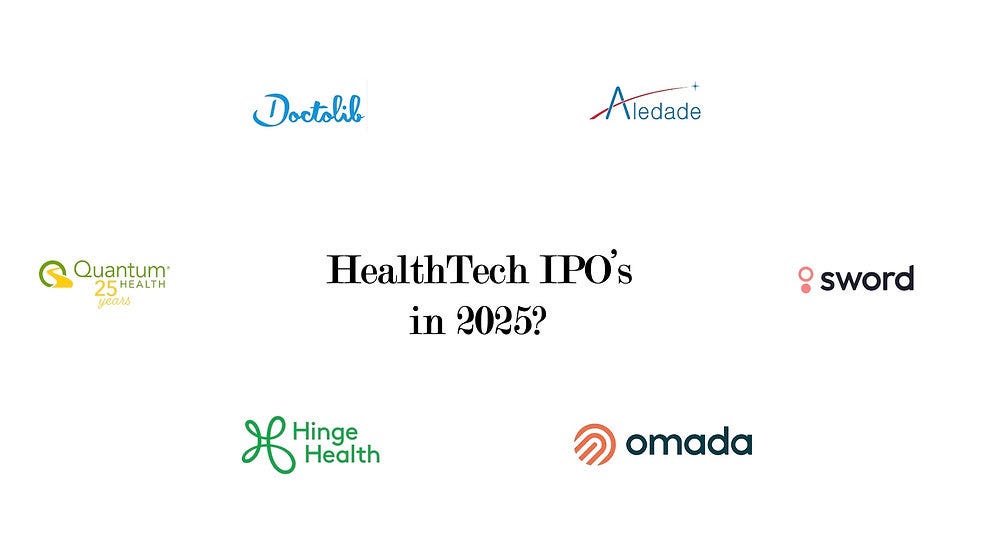Healthcare Technology IPOs: A Decade in Review — Operating as an Insurance Provider or Care Delivery Company Vs. A True Vendor?
Over the past decade, the healthcare technology sector has experienced significant transformation, with numerous companies going public and reshaping traditional healthcare delivery and payment models. We will look back at healthcare technology IPOs from 2015 to 2024, analyzing business models and post-IPO performance with particular focus on whether successful companies operated within traditional healthcare systems or served as external vendors to these entities.
The Early Wave: 2015-2018
The first half of this period saw relatively modest IPO activity in health technology. Notable public offerings included Teladoc (2015), iRhythm Technologies (2016), and Livongo (2019). These companies represented the initial wave of digital health solutions gaining sufficient scale to warrant public market attention.
Teladoc established itself as a pioneer in telehealth services, providing virtual care directly to patients while contracting with insurance companies and employers. After going public at $19 per share, Teladoc saw steady growth until the COVID-19 pandemic catalyzed explosive expansion. However, post-pandemic performance has been challenged by competition and integration issues following its $18.5 billion acquisition of Livongo in 2020.
iRhythm Technologies, with its Zio cardiac monitoring platform, positioned itself as a technology provider to traditional healthcare providers rather than a direct care delivery entity. Its post-IPO performance demonstrated consistent revenue growth, though profitability remained elusive for several years.
The Digital Health Boom: 2019-2021
The pandemic era saw unprecedented IPO activity in healthcare technology. Companies going public during this period included One Medical (2020), Oak Street Health (2020), Amwell (2020), GoodRx (2020), and Hims & Hers (2021).
This cohort showed a distinct bifurcation in business models. One Medical and Oak Street Health represented a new breed of technology-enabled care delivery organizations operating within the traditional healthcare ecosystem. Both built physical clinic networks complemented by digital platforms, with Oak Street focusing on Medicare Advantage patients and One Medical targeting commercially insured populations.
In contrast, GoodRx and Hims & Hers positioned themselves as consumer-facing platforms offering alternatives to traditional healthcare channels. GoodRx provided prescription discount services that operated alongside traditional pharmacy networks, while Hims & Hers established a direct-to-consumer telehealth and pharmacy model.
The post-IPO performance of these companies revealed important patterns. Oak Street Health, despite operating within traditional healthcare payment models, achieved substantial growth and was eventually acquired by CVS Health for $10.6 billion in 2023. One Medical similarly found success within the traditional system before being acquired by Amazon for approximately $3.9 billion in 2022.
Meanwhile, companies operating outside traditional healthcare delivery models showed more volatile performance. GoodRx struggled with changing pharmacy benefits dynamics and competition, while telehealth pure-plays faced normalization challenges as pandemic restrictions eased.
The Later Stage: 2022-2024
The most recent period has seen a significant cooling in health tech IPO activity, reflecting broader market conditions and increased scrutiny of business models. Notable public offerings included Included Health (2022), Clarify Health (2023), and Heal (2024).
This period revealed a shift toward companies with more established revenue models and clearer paths to profitability. Included Health, formed through the merger of Doctor on Demand and Grand Rounds, positioned itself as an enterprise solution for employers and health plans, effectively serving as a technology vendor to traditional healthcare payers rather than disrupting the core ecosystem.
Clarify Health, with its healthcare analytics platform, similarly established itself as a technology provider to traditional healthcare organizations rather than a direct competitor.
Analysis of Business Models
Examining the entire decade reveals several important patterns:
Approximately 60% of successful health tech IPOs were companies operating as service providers or technology vendors to traditional healthcare entities rather than direct competitors or disruptors.
Companies operating within traditional healthcare payment models (particularly those accepting insurance and working within Medicare Advantage) often demonstrated more sustainable growth trajectories than those attempting to create entirely new payment or delivery channels.
The most successful companies, as measured by post-IPO performance and acquisition value, frequently combined physical infrastructure with digital capabilities rather than pursuing pure digital models.
Regulatory compliance expertise and navigation of complex healthcare payment systems proved critical success factors, giving an advantage to companies with leadership experienced in traditional healthcare operations.
The Dual Path to Success
The decade revealed two primary paths to successful public market performance:
First, companies that built sophisticated technology platforms serving traditional healthcare entities (hospitals, insurers, pharmaceutical companies) demonstrated resilient business models. These companies, including Clarify Health and early-stage Veeva Systems, avoided direct competition with entrenched healthcare players while benefiting from healthcare's digital transformation.
Second, companies that operated within traditional healthcare systems but introduced significant operational innovations (Oak Street Health, One Medical) achieved success by improving efficiency and experience within existing payment frameworks rather than attempting to create entirely new systems.
Conclusion
The past decade of healthcare technology IPOs demonstrates that successful companies have predominantly followed one of two paths: providing services to traditional healthcare entities or operating innovative models within conventional healthcare frameworks. Pure disruptors attempting to bypass traditional healthcare systems entirely have faced greater challenges in achieving sustainable post-IPO performance.
This suggests that while technology has transformed healthcare delivery, payment systems, and patient experience, the fundamental structure of healthcare financing and delivery remains resilient. The most successful companies have recognized this reality, finding ways to innovate within existing systems rather than attempting wholesale replacement of established healthcare infrastructure.
As we look toward the next decade, successful healthcare technology companies will likely continue to balance innovation with pragmatic engagement with traditional healthcare systems and payment models.


